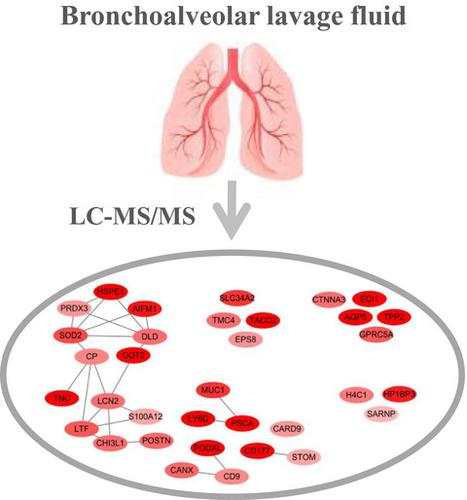Our official English website, www.x-mol.net, welcomes your
feedback! (Note: you will need to create a separate account there.)
Proteomic characteristics of bronchoalveolar lavage fluid in critical COVID-19 patients
The FEBS Journal ( IF 5.5 ) Pub Date : 2020-10-24 , DOI: 10.1111/febs.15609 Hao-Long Zeng 1 , Di Chen 2 , Jingjun Yan 2 , Qing Yang 3 , Qiang-Qiang Han 4 , Shu-Sheng Li 2 , Liming Cheng 1
The FEBS Journal ( IF 5.5 ) Pub Date : 2020-10-24 , DOI: 10.1111/febs.15609 Hao-Long Zeng 1 , Di Chen 2 , Jingjun Yan 2 , Qing Yang 3 , Qiang-Qiang Han 4 , Shu-Sheng Li 2 , Liming Cheng 1
Affiliation

|
Up to 10–20% of patients with coronavirus disease 2019 (COVID-19) develop a severe pulmonary disease due to immune dysfunction and cytokine dysregulation. However, the extracellular proteomic characteristics in respiratory tract of these critical COVID-19 patients still remain to be investigated. In the present study, we performed a quantitative proteomic analysis of the bronchoalveolar lavage fluid (BALF) from patients with critical COVID-19 and from non-COVID-19 controls. Our study identified 358 differentially expressed BALF proteins (P < 0.05), among which 41 were significantly changed after using the Benjamini–Hochberg correction (q < 0.05). The up-regulated signaling was found to be mainly involved in inflammatory signaling and response to oxidative stress. A series of increased extracellular factors including Tenascin-C (TNC), Mucin-1 (KL-6 or MUC1), Lipocalin-2 (LCN2), periostin (POSTN), Chitinase 3-like 1 (CHI3L1 or YKL40), and S100A12, and the antigens including lymphocyte antigen 6D/E48 antigen (LY6D), CD9 antigen, CD177 antigen, and prostate stem cell antigen (PSCA) were identified, among which the proinflammatory factors TNC and KL-6 were further validated in serum of another thirty-nine COVID-19 patients and healthy controls, showing high potentials of being biomarkers or therapeutic candidates for COVID-19. This BALF proteome associated with COVID-19 would also be a valuable resource for researches on anti-inflammatory medication and understanding the molecular mechanisms of host response.
中文翻译:

危重 COVID-19 患者支气管肺泡灌洗液的蛋白质组学特征
多达 10-20% 的 2019 年冠状病毒病 (COVID-19) 患者由于免疫功能障碍和细胞因子失调而发展为严重的肺部疾病。然而,这些危重 COVID-19 患者呼吸道的细胞外蛋白质组学特征仍有待研究。在本研究中,我们对来自重症 COVID-19 患者和非 COVID-19 对照组的支气管肺泡灌洗液 (BALF) 进行了定量蛋白质组学分析。我们的研究确定了 358 个差异表达的 BALF 蛋白(P < 0.05),其中 41 个在使用 Benjamini-Hochberg 校正后发生了显着变化(q < 0.05)。发现上调的信号传导主要参与炎症信号传导和对氧化应激的反应。一系列细胞外因子增加,包括 Tenascin-C (TNC)、Mucin-1 (KL-6 or MUC1)、Lipocalin-2 (LCN2)、periostin (POSTN)、Chitinase 3-like 1 (CHI3L1 or YKL40) 和 S100A12 ,并鉴定出抗原包括淋巴细胞抗原6D/E48抗原(LY6D)、CD9抗原、CD177抗原和前列腺干细胞抗原(PSCA),其中促炎因子TNC和KL-6在另外30人的血清中得到进一步验证。 - 九名 COVID-19 患者和健康对照者,显示出成为 COVID-19 生物标志物或治疗候选者的巨大潜力。
更新日期:2020-10-24
中文翻译:

危重 COVID-19 患者支气管肺泡灌洗液的蛋白质组学特征
多达 10-20% 的 2019 年冠状病毒病 (COVID-19) 患者由于免疫功能障碍和细胞因子失调而发展为严重的肺部疾病。然而,这些危重 COVID-19 患者呼吸道的细胞外蛋白质组学特征仍有待研究。在本研究中,我们对来自重症 COVID-19 患者和非 COVID-19 对照组的支气管肺泡灌洗液 (BALF) 进行了定量蛋白质组学分析。我们的研究确定了 358 个差异表达的 BALF 蛋白(P < 0.05),其中 41 个在使用 Benjamini-Hochberg 校正后发生了显着变化(q < 0.05)。发现上调的信号传导主要参与炎症信号传导和对氧化应激的反应。一系列细胞外因子增加,包括 Tenascin-C (TNC)、Mucin-1 (KL-6 or MUC1)、Lipocalin-2 (LCN2)、periostin (POSTN)、Chitinase 3-like 1 (CHI3L1 or YKL40) 和 S100A12 ,并鉴定出抗原包括淋巴细胞抗原6D/E48抗原(LY6D)、CD9抗原、CD177抗原和前列腺干细胞抗原(PSCA),其中促炎因子TNC和KL-6在另外30人的血清中得到进一步验证。 - 九名 COVID-19 患者和健康对照者,显示出成为 COVID-19 生物标志物或治疗候选者的巨大潜力。











































 京公网安备 11010802027423号
京公网安备 11010802027423号